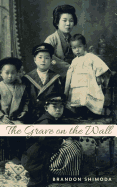
By the time Brandon Shimoda's grandfather died in 1996, he had been living with Alzheimer's for almost 20 years. Shimoda was then a college freshman, which meant he had had little opportunity to know the man without the disease. Reacting to "the loss--the losing," Shimoda started writing The Grave on the Wall almost a decade ago, collaging other people's memories, documentation and transcripts in search of Midori Shimoda, his father's father. The compelling result is a meditative memoir-of-sorts about his grandfather, his extended family, his ancestral heritage and ultimately himself as a 21st-century Japanese American.
Midori was conceived in Hawaii and born--in 1909 or 1910 or 1911, depending on who is remembering--on an island off the coast of Hiroshima. At nine, he immigrated to the U.S., where he lived the rest of his life. During World War II, he was one of 120,000 Americans of Japanese ancestry imprisoned without cause: his Japanese birth classified him as "enemy alien"; being a photographer with a camera landed him in unlawful confinement at Fort Missoula, Mont., where he was "held under pretext of being a threat to the national security of [this] country."
Decades later, Brandon Shimoda made his first visit to Missoula, "to the ruins of Japanese American incarceration, [and] found Midori's face" in a photograph hanging on the barracks wall. The unexpected discovery becomes, for Shimoda, "Midori's grave, because it is... the first, most accessible, place [he] could visit [Midori] after death." Through his expansive pursuit, Shimoda alchemizes his family's recollections and confessions, his country's trespasses, his legacy of loss, into elegant, haunting testimony. --Terry Hong, Smithsonian BookDragon

